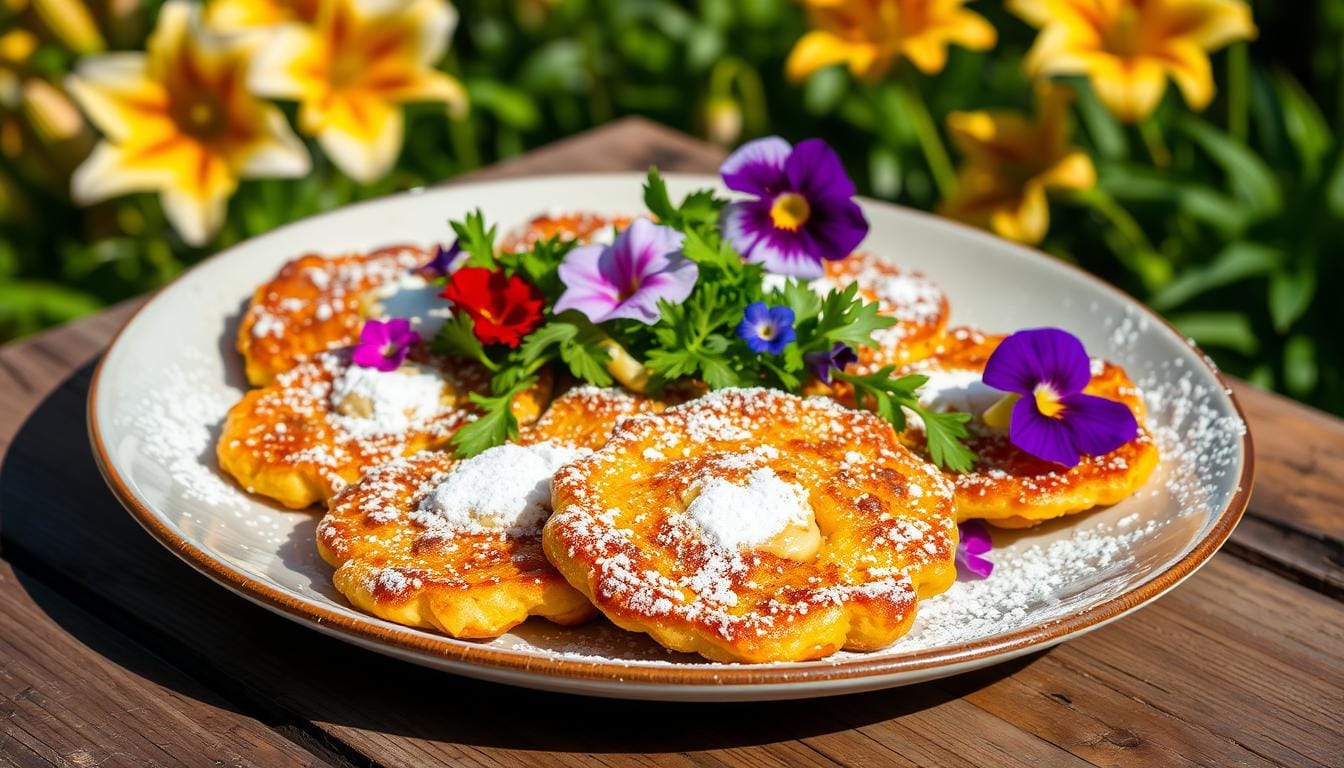As the sun dances across your vibrant garden, the daylily blooms call to you. They invite you to pick their delicate petals and make a tasty treat. This simple recipe lets you enjoy the flavors of your garden, turning it into a gourmet paradise. Let’s dive into the world of foraging and making these crispy, golden fritters together.
Daylilies are a favorite for their bright colors and playful look. They grow well in many climates, making them perfect for any garden. But there’s more to them than meets the eye. They’re edible, and when cooked right, they can take your meals to the next level.
Table of Contents
Cultivating Daylilies: A Hardy Perennial for Easy Gardening
Daylilies (Hemerocallis) are easy to grow and need little care. They do well in many soils and climates. These colorful flowers are great for any garden, whether you’re new to gardening or have lots of experience.
Choosing Daylily Varieties for Your Garden
There are thousands of daylily types to choose from. Think about the color, size, and when they bloom when picking. You can find everything from bright orange Hemerocallis fulva to the sweet-smelling Hyperion with its lemon-yellow flowers.
Planting and Caring for Daylily Blooms
- Daylilies love full sun to partial shade and well-drained soil.
- Plant them in the spring or fall, leaving 12-24 inches between each.
- Remove spent flowers to keep them blooming all season.
- Split up crowded plants every 3-4 years to keep them healthy.
Daylilies are perfect for both new and seasoned gardeners. By picking the right types and caring for them, you’ll get lots of beautiful daylily flowers every year.
“Daylilies are known to produce vibrant blooms that last for a single day.”
Harvesting Daylily Blooms for Culinary Delights
Daylily blooms are not just beautiful in the garden; they’re also edible. Their delicate, slightly sweet flavor can make many dishes better. You can use them in salads, stir-fries, fritters, and even in wine.
To enjoy daylily blooms in cooking, pick them when they’re fully open and vibrant. Make sure they’re free from any damage. Gently take off the petals, leaving the green base and stamen. Then, rinse and dry them well before using them in your recipes.
Daylily blooms can add elegance and flavor to many dishes. Try making stuffed daylily flowers, daylily fritters, or just add them to salads and stir-fries. The options are endless for using these beautiful, edible flowers.
Exploring edible daylily flowers is exciting. Enjoy their vibrant colors and unique flavors. Use daylily petals to make dishes that show off your garden’s bounty.
The Art of Foraging: Wild Edibles in Your Backyard
Foraging for wild edibles in your backyard or local green spaces is rewarding. It’s a sustainable way to add seasonal, locally-sourced ingredients to your meals. When picking edible flowers like daylilies, it’s key to know which ones are safe. Also, follow ethical foraging techniques to protect the environment.
Identifying Safe and Edible Flowers
Not all flowers are safe to eat. So, it’s important to carefully identify the edible species before using them in cooking. Some common edible flowers found in backyards or local green spaces include:
- Daylilies (Hemerocallis spp.)
- Nasturtiums (Tropaeolum spp.)
- Violets (Viola spp.)
- Chamomile (Matricaria recutita)
While many flowers are edible, it’s wise to check with a knowledgeable forager or field guide. This ensures you’re picking and harvesting safe wild foods.
Ethical Foraging Practices
When foraging for wild edibles, following ethical practices is crucial. This helps keep the ecosystem healthy. Remember to:
- Only take a small part of the plant, so the rest can grow
- Avoid taking too much, which can harm the plant’s ability to reproduce
- Get permission before foraging on land that’s not yours
- Dispose of waste or plant material properly to reduce environmental impact
By following these ethical foraging practices, you can enjoy nature’s gifts. This way, you help ensure these valuable wild resources last for future generations.
“Foraging is a way to connect with the natural world and appreciate the abundance that surrounds us, if we just open our eyes to it.”
daylily fritter recipe: A Seasonal Indulgence
Enjoy the fresh taste of your garden with a tasty daylily fritter recipe. These golden treats highlight the sweet taste of daylily petals. They offer a unique taste experience from your own garden. Treat yourself to this seasonal delight as a special appetizer or snack.
Daylilies add beauty to any garden and are great in the kitchen too. Their petals make a variety of tasty dishes, like daylily fritters. With a simple batter and quick fry, your garden’s bounty turns into a delicious snack.
“Daylily fritters are a must-try for any home cook looking to explore the culinary wonders of their garden. The combination of crispy texture and sweet, floral flavor is simply divine.”
Whether you’re a seasoned forager or new to gardening, daylily fritters are a great choice. They help you make the most of your backyard’s natural gifts. Enjoy the tasty possibilities that daylilies bring to your cooking.
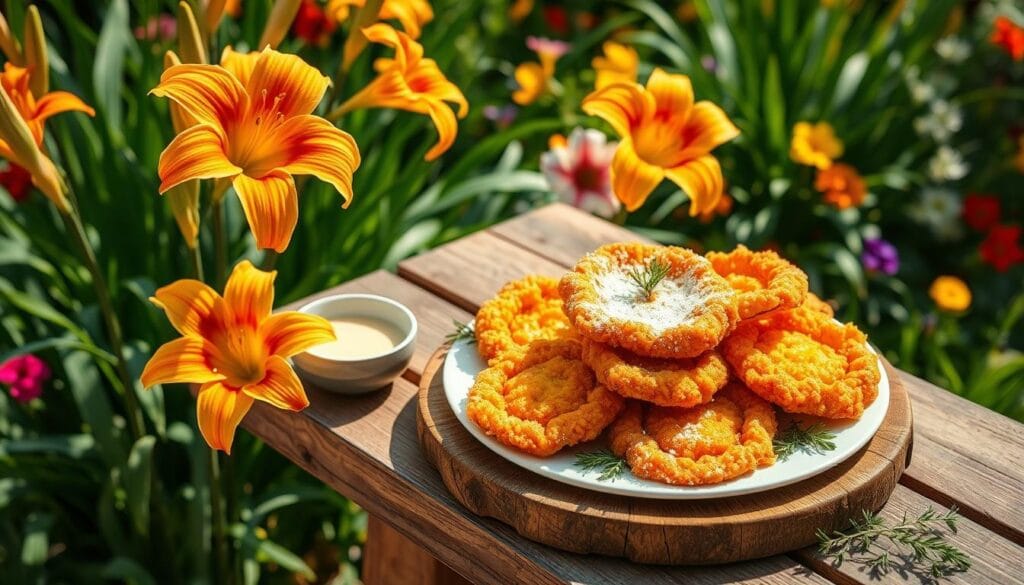
So, pick your fresh daylily blooms and let’s make these amazing daylily fritter recipe. Enjoy the special flavors and textures of this fried flower recipe. Celebrate the daylily culinary uses in your seasonal cooking adventures.
Preparing the Perfect Fritter Batter
Making the perfect batter is key for light and crispy daylily fritters. The right mix of dry and wet ingredients, along with good frying techniques, makes a tasty, golden fritter. This fritter highlights the daylily blooms’ natural sweetness.
Ingredients and Techniques for Light and Crispy Fritters
To get the best fritter batter recipe, just follow these easy steps:
- Begin with all-purpose flour, cornstarch, and a bit of salt. Cornstarch makes the fritters light, and salt boosts the taste.
- Then, mix in beaten eggs, milk, and a bit of sugar. This makes the batter smooth and pourable. Eggs and milk add richness and help the ingredients stick together.
- Heat oil to 350°F in a deep fryer or a heavy pan. Carefully add spoonfuls of batter to the hot oil, avoiding too many at once.
- Fry the fritters until they’re golden and crispy, flipping them to cook evenly. Then, drain them on a paper towel to get rid of extra oil.
By following these steps, you’ll make perfect daylily fritters. Your guests will love their crunchy texture and natural sweetness.
Deep-Frying Secrets: Achieving Golden Perfection
Mastering deep-frying is key to perfect daylily fritters. You need the right frying temperature, oil type, and deep-frying techniques. These steps help get a crispy outside and a tender, flavorful inside. Learn these secrets to make your homemade daylily fritters a hit.
The frying temperature is very important. Keep the oil between 350°F and 375°F. This ensures even cooking and a nice crunch. Use a deep-fry or candy thermometer to keep an eye on the temperature.
Choosing the right oil is also crucial. Use peanut, vegetable, or canola oil, as they handle high heat well. Olive oil is not good for deep-frying because it burns easily and tastes bitter.
- Keep the oil temperature steady by adjusting the heat. Sudden drops can make fritters soggy and greasy.
- Fry fritters in small batches to keep the oil temperature up. This way, you get crispy fried foods every time.
- Drain fritters on a paper-towel-lined plate to get rid of extra oil and achieve a golden finish.
“The secret to deep-frying perfection lies in the careful control of temperature and technique. Mastering these elements will transform your homemade daylily fritters into a delightful culinary triumph.”
By using these deep-frying techniques, you’ll make daylily fritters that are a treat for the senses. They’ll be crispy outside, tender inside, and full of fresh flavors. Your fritters will be the star of the show.
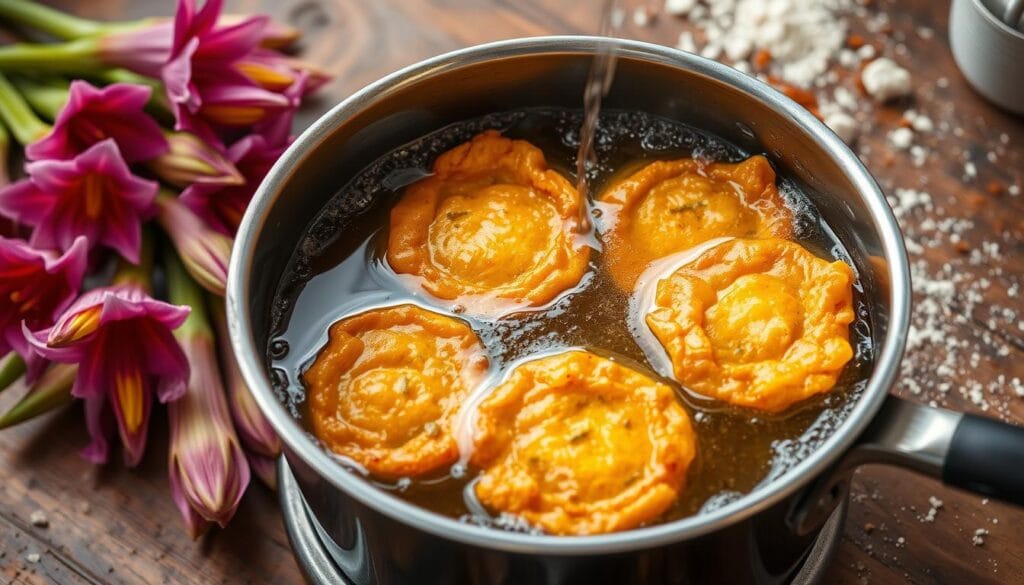
Serving and Garnishing Your Daylily Fritters
Make your daylily fritters stand out by pairing them with dips and sauces. These can bring out the natural sweetness of the blooms. Try tangy chutneys or creamy yogurt-based dips and sauces for fritters to enhance your dish. Adding fresh herbs, edible flowers, or powdered sugar can also make your fritters look great.
Complementary Dips and Sauces
Try different dipping sauces and condiments to find the best match for your serving daylily fritters. Here are some tasty options:
- Tangy Daylily Flower Chutney: A vibrant condiment that balances the sweetness of the fritters with a touch of acidity.
- Creamy Lemon-Herb Yogurt Dip: A refreshing and cooling accompaniment that complements the fried garnishes for fried flowers.
- Sweet and Spicy Apricot Glaze: A versatile sauce that adds a unique flavor profile to the daylily fritters.
Feel free to mix and match flavors to find the perfect match for your dish.
“Embracing the natural sweetness of daylily blooms with complementary flavors is the key to creating a truly memorable dining experience.”
Culinary Foraging: Embracing Seasonal and Local Ingredients
Start exploring culinary foraging to celebrate the fresh, local ingredients in your cooking. Wild edibles like daylily blooms can make your dishes unique and flavorful. They show off the natural beauty of your area.
Foraging connects you to nature and promotes sustainability. It adds magic to your cooking. From the taste of Smyrnium perfoliatum to Polygonatum hirtum’s sweet shoots, foraging offers many seasonal treats.
- Explore the edible potential of Hosta varieties like “Decorata” and Hosta undulata var albomarginata.
- Discover the “King of the Edible Vegetables,” Crambe maritima (sea kale), and the young shoots of Gunnera “manicata” enjoyed in the Far East.
- Embrace the historical significance of Hemerocallis sp. (daylily), the world’s oldest documented vegetable.
Culinary foraging lets you connect with different cultures. It introduces you to new plants and flavors. Try Musa basjoo’s nectar and leaves, or Staphylea holocarpa’s young leaves and flower clusters as a cauliflower substitute.
“Foraging for wild edibles not only connects us to the natural world but also adds a unique and flavorful dimension to our cooking.”
Start your culinary foraging journey. Let your backyard’s seasonal ingredients inspire your cooking.
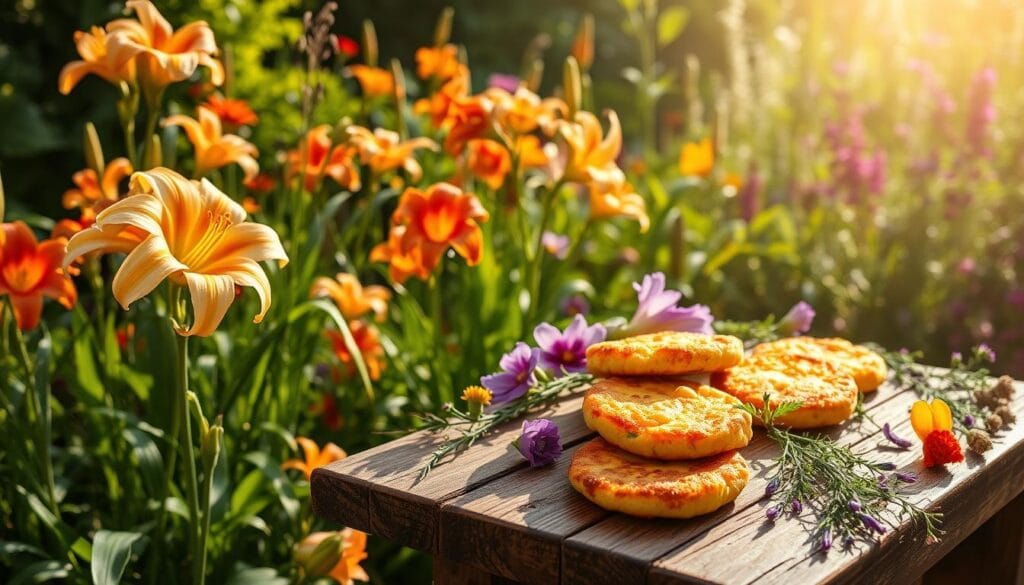
Conclusion
Daylily fritters are a tasty way to enjoy your garden’s blooms. By growing these hardy plants and foraging for their flowers, you can make a special summer treat. You can make the fritters even better by using the right batter and frying techniques.
Adding dips and sauces can make them even more delicious. Foraging connects you to nature and lets you use fresh, local ingredients. Enjoy making daylily fritters and the joy of using your backyard’s bounty.
The South Carolina Farm Bureau Marketing Association is expanding its grain elevator. This project will nearly double storage space and add new features. It shows the association’s dedication to helping farmers across the state.
This move supports more farmers in the area. It also shows the organization’s long-term goal to protect and promote its members’ interests. The association has 95,000 member families.
Authors like Holly Searcy and Saul are changing the literary world. Searcy’s “The Shiver Tree” takes readers to Amarra, a magical place. Saul’s “Dogwhistles and Figleaves” explores racism and public talk.
These books are thought-provoking and inspire readers to think about big issues. They show how language can shape our views and society.
FAQ
Q: What are daylily fritters?
Q: Are daylily flowers edible?
Q: How do I properly identify and harvest daylily flowers for cooking?
Q: What are the key ingredients and techniques for making the perfect daylily fritter batter?
Q: What is the secret to deep-frying daylily fritters to perfection?
Q: What are some delicious ways to serve and garnish daylily fritters?
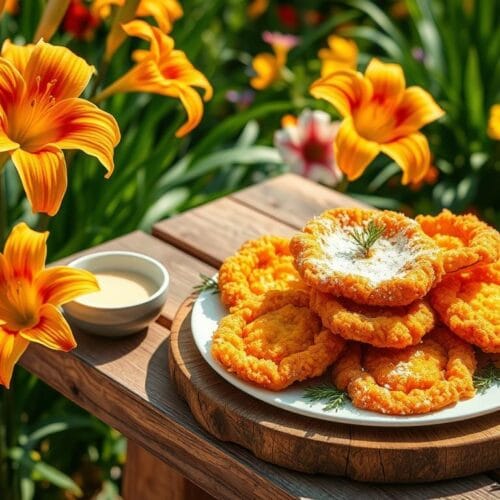
Daylily Fritters Recipe
Ingredients
- 1 cup daylily petals fresh, vibrant, and free from damage
- 1 cup all-purpose flour
- 2 tablespoons cornstarch
- 1 teaspoon salt
- 1 tablespoon sugar optional
- 1 large egg
- 3/4 cup milk or enough for a smooth batter
- Oil for frying peanut, vegetable, or canola
Notes
- Oil Temperature: Maintaining the correct oil temperature is crucial for crispy fritters. Adjust the heat as needed to keep it steady.
- Variations: Feel free to add herbs or spices to the batter for extra flavor, such as garlic powder or chopped fresh herbs.

